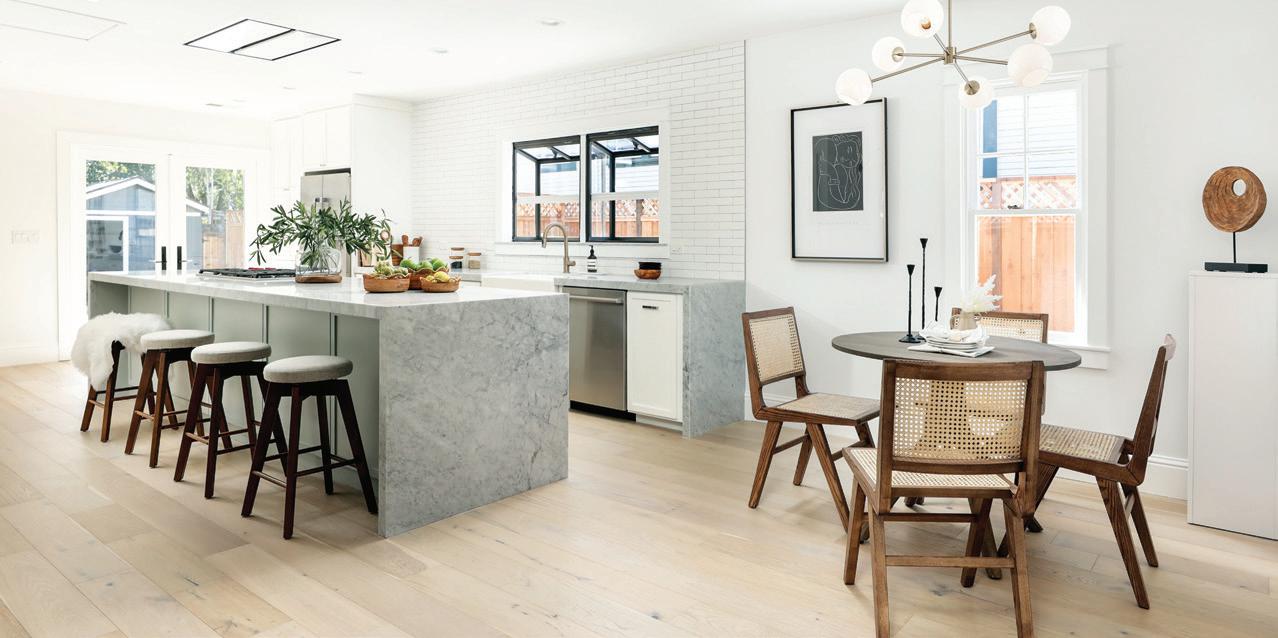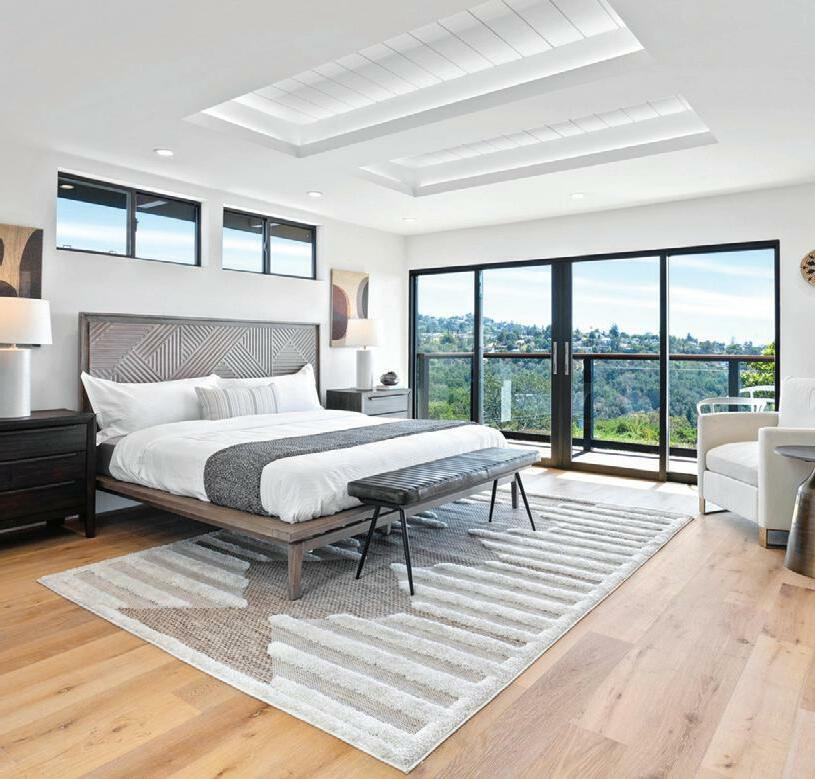
31 minute read
INSPIRE
WHAT’S NEW IN ANCILLARY INCOME
From lifestyle services to guest suites, investigating the amenities and offerings that improve resident experience and retention as well as enhance the bottom line.
Advertisement
Developers, owners and managers have engaged in amenity wars for years to woo residents. One strategy has been using the right mix of features and services, which often need to change over time.
Many were historically offered gratis or were built into lease payments, but as the options have increased, so too have the expenses.
Despite recent rent increases across the country, some of this additional revenue has been offset by increased labor costs, insurance, maintenance and taxes, among other expenses. This leaves many owner-operators challenged to find a revenue-expense balance and achieve a strong bottom line.
When it comes to ancillary revenue, as well as cutting expenses tied to amenities and other services that have lost resident appeal, current offerings tend to combine perennial favorites that can make a difference in residents choosing one property over another. Some reflect regional trends and age and income demographics. Some are designed to generate buzz and heighten visibility, locally or nationally. And there may be periodic experiments to see what might become a go based on what competitors are introducing.
STRUCTURING PAYMENT
One difference among companies is how they charge: As a separate consolidated fee for amenities and more, like a hotel resort fee; as individual fees, each billed separately; or as freebies or small charges.
“In our residential portfolio of mostly workforce housing, we don’t charge extra but build costs into monthly rent,” says Kelman. “Rather than try to squeeze residents, we have tried to provide additional value-added services we pay for. You have to know your market and building demographics. Some of our residents have very challenging work schedules and offering some form of fitness activity they can do at home helps when they don’t have time to go to a gym. We’re also exploring partnerships for more expanded wellness services that would probably be at a modest additional cost,” he says.
However, Melanie Gersper, Chief Operating Officer of Atlanta-based ACRE, which develops, acquires and manages 10,000 units in seven states, thinks it’s better not to build charges into rent because it makes it harder to compare one building versus another. For ancillary expenses, her company charges separately.
Brian Gretkowski’s Bloomfield, N.J.-based Sparrow Asset Management firm, which manages nine assets and also does consulting work, operates similarly. It prefers to charge a lower rent and set an amenity fee for multiple services, typically charged as an annual fee per lease. It spells out what residents get for their money—fitness center, pet wash, resident lounge, rooftop, workfrom-home (WFH) spaces, lobby with beverages—he says.
The following are popular ways that properties use to realize additional income. Whichever strategies firms choose, they know to make the costs, what they cover and for how long absolutely transparent to residents.
LIFESTYLE/CONCIERGE SERVICES
These have become more popular. Not venturing off the property saves time, says Chicago-based commercial interior designer Mary Cook, whose company, Mary Cook Associates, is a fully integrated commercial interiors firm working with premier real estate owners and developers. “The concierge-style services such as housekeeping, package handling, dog walking, as well as programming of social activities targeted to the demographic, are low-cost, high-impact programming amenities, which help to streamline and simplify life for residents,” she says. Having services onsite also helps to create a sense of community, which, in turn, may help retain residents. “If people make friends, they’re less likely to move,” Cook says.
Many buildings charge separately for such services, from $25 to $40 a month or so. In general, many residents will pay to have their dry cleaning sent out and picked up, apartment cleaned, trash picked up at their door—referred to as valet service—rather than walk down a hall and throw it in a chute, Hawthorne says.
PARKING
Buildings with garages tend to set prices according to a market’s rate and cost to build the covered structure or surface lot, plus keep it clean and possibly offer surveillance, Hawthorne says. Even within one building, charges may vary depending on whether a space is reserved or represents a premium loca-
By Barbara Ballinger


tion—for instance closer to an elevator, Hawthorne says. Some buildings pay a third-party operator to collect fees and share revenue for services such as parking, Gretkowski says.
TECHNOLOGY PACKAGE
Because people are spending more time working from their apartments, many have higher expectations about having the best possible connectivity for their phone, laptop, thermostat, speakers, and even their doorbell for security. “This is something most are willing to pay for,” Hawthorne says. His company bundles these services and charges a range, depending on what it offers, possibly $60 to $70 a month, he says. “It’s separate from an amenity or lifestyle fee,” he says.
STORAGE LOCKERS
Many buildings charge for individual or group lockers separate from amenity spaces and package rooms, which may give residents a place for their overflow such as furniture and out-of-season clothing. The key for these rooms is having a card, key, or fob to enter. In Denver, these are often called a “gear closet” and designed to keep skis, snowboards, fishing poles and other outdoor equipment, says Cook. In Florida, they may be used to keep beach chairs, umbrellas and strollers for when grandchildren visit, she says. How they’re operated—by the property or third-party vendor— varies, she says. Prices vary too by size and location. In New Jersey, most run between $50 and $100 a month, Gretkowski says.
AMENITY SPACES
Some rooms continue to be offered for free such as gyms, but others are part of a yearly amenity fee or subject to periodic charges when booked for an event. The same type of policy may be applied when buildings make a personal trainer or yoga instructor available. Sometimes, cost depends on how nice and new a space is. “If it’s an old-school clubhouse with a few chairs and sink, residents usually won’t pay, but if it feels like a club room with a resort feel and has a pool and hot tub, that may be different,” Gersper says.
DEPOSIT FEES
Deposit fees used to be equal to one- or one-and-a-half-month’s rent and charged when residents first leased an apartment. The funds were returned if the apartment was left in broomswept condition. If there were problems, money was deducted. But some managers now charge $30 a month for alternative programs, referred to as “no deposit programs,” Gretkowski says. These programs allow residents to pay a smaller monthly fee rather than provide a full deposit upfront. Money isn’t typically returned at the end of a lease, he says.
RENTERS’ INSURANCE
In past years, it was up to renters to secure insurance if they wanted it, but many developers now insist on taking out policies and charging residents for coverage. That way they know the renter is adequately covered, Gersper says. “Some like it and some don’t, but it’s not that much, maybe $11 or so a month,” she says.
GUEST SUITES
Some buildings have set aside space for furnished suites they rent to residents’ guests at rates that usually are more affordable than local hotels and VRBO/ Airbnb properties, says Gersper.
FOOD AND DRINK
Offering food has become a highly popular option, particularly as COVID ramped up and more residents worked from home. More food trucks visit properties and pay a flat fee to the building. Many communities collaborate with local entertainment venues, restaurants, and coffee shops to incentivize contribution to the local community by offering residents discounts and other incentives, Cook says. Small grab-and-go grocery/convenience stores are also popping up, sometimes in a lease center, which adds activity plus a payback to the building. They often stock products different demographics want. “We curate for climates, stocking suntan lotion in warm weather locales,” Lynd says. In the future, pet food may be available through vending machines 24 hours a day. “We’re not there yet but looking at possibilities,” Williams says.
KEY FOBS
Some buildings give one or two keys to a renter and charge extra for others, maybe $50 to $100 each, Gersper says. “As more younger Millennials move into apartments, they want dog walkers and cleaners to have access, and many renters will purchase more keys as a convenience,” she says. At Hawthorne’s properties, it prefers to limit access for security to lease holders, so no extra fobs are available, he says. “Some may balk, but we try to hit home the value of what we are doing,” he says.
AND YES, PETS = DOLLARS
The influx of pets in buildings has spurred many properties to recognize an opportunity for money and they often charge by breed and size. “If you don’t allow pets, you lose a decent portion of the renter pool,” says Gretkowski. In northern New Jersey, properties typically charge $500 upfront, plus $50 per month for pets. The same fee structure applies to all pets regardless of size or breed. The Lynd Group also views pets as a good source of income since 70% of its residents have a pet. “We love, cater to them, and accept any breed or size,” he says.
MORE APPS = CONSOLIDATION
Because the number of services is increasing, some buildings add a centralized app that residents can use with local businesses to schedule services related to their home such as home cleaning or dog walking, in addition to paying rent or submitting service requests, says Williams. “The goal is to create efficiency for our team members so they can focus on the resident,” she says. “We leverage our scale to bundle technology services, so we are able to provide competitive and comprehensive offerings to our residents,” says Williams, whose company manages 35,000 units in seven states.
Reprinted with permission from the National Apartment Association.


Inspire
STYLISH INTERIOR DESIGN FOR SHORT-TERM RENTALS INCREASES ROI


There are so many options out there for short-term rentals. How do you pick? Proximity to attractions, numbers of beds, baths and other key amenities. After much filtering, I usually still find tons of options available. Here is where I start to take a deep dive into the options.
Oftentimes, I find that the nightly cost of these rentals vary greatly. There is certainly the “going rate” where most listings hover slightly above or below. However, a small portion of the listings are priced above average. Some even go as much as 50 percent or more above average. Take a closer look at these above-average listings and you will find superior interiors.
Much like a high-end hotel, these above-average listings appear as if they have been designed by a professional interior designer – stylish, comfortable and functional. Images are magazine-quality, and the descriptions are equally as eloquent. The increased nightly cost does not appear to be a deterrent as these listings are typically booked up with a high-occupancy rate.
High-occupancy rate at higher nightly rate certainly brings in a nice return on investment (ROI). However, some upfront investments are required to achieve these superior interiors. As a professional interior designer, I have some tips and tricks to achieve the designer look to increase your ROI without breaking the bank. We will deep dive into each key category, starting from the floor up!
Flooring: Rip off that carpet and replace it with hard flooring everywhere. Carpets collect dust and stains. They are hard to clean and show wear and tear with routine cleaning. One caveat with hard flooring is vinyl sheet flooring, not to be confused with vinyl plank flooring, which is still a good choice for short-term rentals. Vinyl sheets have gone out of style. Beyond the aesthetics, I do not enjoy the unnatural-touch feel of the vinyl sheets on my feet.
Laminate flooring is the number one choice for short-term rentals. Laminate flooring works in all of the common areas as well as bedrooms, providing continuity to open-concept multi-use spaces. It is durable enough to withstand high foot traffic and little paw scratches. The flooring’s water-resistance also makes it a great choice for the kitchen. However, tile would be a better choice than laminate in the bathrooms as tile is waterproof whereas laminate is only water-resistant. Both laminate and tile come at an affordable price point.
In terms of color, lighter oak has been a popular choice in recent years, and I do not see that changing anytime soon. Light yellow and brown hues give a warm and cozy feeling to the home. Avoid gray tones.
Paint: Let’s talk colors! Light and white or light taupe gray have been popular color options in the past year, and I expect it to continue. Recently, I have seen the same light color being used on the walls extended onto the ceiling as well to provide continuity. Lighter walls make rooms appear larger. These light walls also pair well with darker furniture that better hide the stains from heavy usage, which you will need in your short-term rental.
Paint finish is also a key factor to consider. The glossier the paint is, the stronger it is. Glossier paints are easier to clean, which is the top choice for areas prone to staining like kitchen cabinets. For a short-term rental, the top choice for walls and ceiling are respectively eggshell and flat. Bathrooms are the exception; this room needs a stronger, glossier finish due to day-to-day usage and moisture. Recommendations for bathroom walls and ceiling are respectively satin and semi-gloss.
Kitchen Cabinets and Counter-
top: Most investors renovate older homes to convert into short-term rentals. If you have the budget to gut and rebuild the whole kitchen, go for it! If the budget is limited and the cabinets are still functional, my advice is to just give them a facelift with a fresh coat of paint and add new hardware. Choose to spend the money on countertop replacement instead because no one truly cares if those drawers are soft-closing in a short-term rental.
Older homes typically come with old-style tile or laminate countertops that immediately devalue your home. If you encounter these old-style countertops, my best advice is to replace them with light-colored quartz. Quartz has been the most popular choice in recent years, and the Quartz countertop trend will likely continue in the years to come. Quartz is an engineered stone, not to be confused with the natural stone – quartzite. It looks and feels like a natural stone but is more durable and comes at a lower
By Ty Karges

price point. What is not to love!
Lighting: Integrated ceiling lights are great, but light fixtures are little jewelry pieces that will make your rental stand out. I recommend creating a point of interest using a chandelier in at least one common area of your listing like dining or living areas. There are limitless options available nowadays at a budget price point.
Ceiling fans with lights are not aesthetically pleasing (e.g., oldstyle fans with three bulbs of lights pointing down). They can also make the ceiling look lower and the room smaller. Short-term rentals should be equipped with a full range of AC and heat temperature controls, hence eliminating the need for a fan. If you must have a fan with a light, choose a modern one with integrated LED lights. However, I highly recommend forgoing the fans and replacing them with flush-mount light fixtures to create a more desirable interior.
Furnishing: Short-term rentals should look stylish but at the same time be functional and comfortable. Leather, wood, and metal furniture pieces might be the first that come to mind as they are more durable and easier to clean than fabrics. However, do not overuse them as they are rigid materials and can make your rental appear uncomfortable.
Another mistake that can make your rentals feel uncomfortable is the lack of rugs. Hard flooring requires rugs in areas like the living room and bedrooms to invoke a sense of comfort. Low-pile rugs made of polymer (like polyester) are a great choice for shortterm rentals. They are durable and are very affordable. I recommend adding a rug pad to make it more cushy and comfy and prevent slipping. Nylon, jute, and wool rugs are also great choices as well for high-traffic areas. However, these materials come at a higher price point.
Most renters are drawn to a great living area. It all starts with an attractive couch, and this should be where most of your furniture budget goes for this room. Most people prefer fabric sofas. I recommend selecting a sofa with performance fabric, which is stain-resistant and easier to clean. Leaving a fabric stain-removal spray under the sink for your renters may also be a good idea. If you cannot fathom having a fabric sofa, leather is also a good choice. White and black leather are out of style, however. Select tan, pewter, green or navy instead. Accent chairs should not be matchy-matchy with the sofa. Try contrasting by using different fabric, design and colors.
As for tips to furnish other rooms, the dining area should have enough seating for the maximum number of people that your rental can host. Bedrooms should have nightstands next to the beds with table lamps on them and an outlet or extension cord nearby to charge the phone. Try fitting a chair or a seating area inside the bedroom if the space allows. A bed should always have a rug underneath it if there is hard flooring. Include a work-fromhome office space to draw in another demographic: remote workers who also love to travel.
Professional help: If all of this is too overwhelming for you, professional interior designers like myself can help. Designers know exactly how to lay out a great floorplan and source appropriately sized furniture. Plus, they will help you ensure that the designs are cohesive throughout the entire home. Picking a local interior designer may prove to be the best option as they come with the tribal knowledge of what is popular in the area. They can also help with branding and incorporating touches that make your shortterm rental unique and local!
Ty Karges is an interior designer for Ty Karges Home.

Property Management Experts Share
TRENDS FOR 2023

By Michelle Gamble
When it comes to the business of property management, 50 different experts shared industry trends for 2023. Their answers cited three common themes expected to impact the property management industry, including: • shifts in renter preferences influencing expectations from rental spaces and how those spaces are managed; • technology applications viewed as essential for sophisticated renters; • help improve business practices and customer service.
RENTER PREFERENCES
An ongoing trend, remote work, will continue to influence the property management industry. Trends are based on shifts in the marketplace and required changes to property management business models to accommodate renter preferences.
At the height of the pandemic in 2020, every industry that could send workers home to work did so. Even as the pandemic settled down, many companies did not call their workers back to the office. As a result, two important trends arose out of the remote and hybrid work models: one, commercial properties experienced high vacancy rates; and two, renters who now work full-time at home have different expectations related to the home office.
Property managers pivoted to stay one step ahead of remote work’s impact on the commercial real estate industry. As of October 2022, “San Francisco has 27.1 million square feet of office space available across the city, a record high, according to new data recently released by commercial real estate firm CBRE.” “The trend of people working from home has not stopped as the globe returns to normalcy,” said Michael Lees, chief marketing officer at EZLease.com. “Remote work has many advantages for employees, but it has had a detrimental impact on the commercial real estate market. Companies that have adopted a telecommuting strategy do not need a traditional office. The value of a commercial real estate is expected to decline further in the coming year, according to several analysts.”

Most importantly, remote workers need more from their homes than ever before. Their homes provide shelter and office space. Renter requirements from their home space has dramatically changed – and this transformation will not stop anytime soon. In fact, most experts predict that when it’s possible to do so, Corporate America will push forward on more remote work. Thus, renter preferences and demands from their home offices have redefined expectations. Property managers who want to successfully fill vacancies need to accommodate remote workers’ needs. Properties that do not embrace the remote work model will be left behind in terms of the competition that does accept the work model.
“Property units combine home living and home office,” said Tia Campbell, director of marketing at Practice Reasoning Tests and property management expert. “Many businesses, including Google, Telus and Microsoft, are delaying the return to work. Some employees may never be required to enter a real office again permanently. This societal transition signifies a new appreciation for dependable high-speed Internet packages, socially separated working places within the building, and access to private outdoor spaces, such as rooftop decks or on-site greenery.
“Renters who work from home may wish to upgrade to a unit with an additional bedroom or space in order to create a home office. We anticipate that new constructions will feature office space and co-working areas. As an increasing num-

ber of individuals value a connection to nature, there may be a rise in demand for buildings located near huge parks.”
This decline in commercial office space use also means property managers require a more diversified portfolio of clients whose holdings go beyond commercial buildings. A premium will be placed on property owners capable of meeting the needs of residential property owners. Property owners will want to work with property managers prepared to manage remote workers’ needs in a timely, efficient manner.
TECHNOLOGY
Remote workers tend to be more sophisticated and educated people. According to a Gallup Poll, 80 percent of remote work comes from white-collar occupations. In the San Francisco Bay Area, workers often work in technology, financial or business industries. This translates to more renters accustomed to technology solutions to do things as simple as pay their rent online or submit maintenance requests through a portal or app. Property managers failing to offer easy ways to manage their renters will not be as attractive to property owners.
“There will be an increase in high-income renters, and they will be ready to pay considerably more,” said Olivia Tonks, marketing manager of Fleet Education. “But regardless of whether they live in a low-density townhouse, condo or apartment, they will demand greater services and facilities. More rent negotiations will take place, particularly given the possibility of 2023 eviction by renters. There would be room for property owners and managers to bargain for higher rents in exchange for better amenities. Everywhere, rents are increasing. You’ll want to sharpen your negotiating techniques and comprehend the terrain.”
However, renters’ needs for cutting-edge customer service can be difficult for small property owners to independently manage. Thus, smaller owners are hiring property managers to provide high-end services that they can’t offer. Property managers who successfully attract this segment of the market will enjoy growth opportunities in 2023, even as the commercial market shrinks.
“According to an industry assessment, rental owners continue to have a higher demand for property managers’ skills than they did before the pandemic,” said Salim Benadel, director at Storm Internet. “From 55 percent in 2019 to 64 percent in 2020, and then remaining consistent at 63 percent in 2021 and 2022, more rental owners now say they have a property manager. The good news is that our surveys have revealed that consulting an expert in these areas significantly lowers stress levels for small real estate owners. Accordingly, small-portfolio investors and accidental property owners alike continue to perceive the benefit of professional proper-

ty management services, despite the urge to keep costs down by maintaining their properties themselves, according to a survey by Buildium.”
The small property owners look to property managers to offer the level of sophisticated services they cannot provide. This means property managers will expand their technology capabilities throughout 2023, which will make their services more in demand and competitive. Property managers falling behind the technology curve will see that business segment go elsewhere.
“Cost control for property management is crucial,” said Erik Wright, owner and CEO of New Horizon Home Buyers. “The demands of the modern era of rental property management and renters’ expectations, in my opinion, have overwhelmed property owners. The services of professional managers are appealing because of their expertise and digital management tools. It is becoming clear to property owners that property management companies can provide real value in the areas of background checks, turnover management, maintenance guidance, rent collection, and government-mandated compliance.”
Expected technology to be embraced includes SaaS, Internet-connected gadgets, cloud services, and automated services. “In actuality, Proptech tools and the work-from-home trend go hand in hand,” said Tom Miller, chief marketing officer at FitnessVolt. “Everyone will require the financial benefits of remote employment, digital service delivery, and high-speed bandwidth. Neighborhoods are getting more fiber-optic service, which is great for property managers and their dispersed personnel. For busy property managers, virtual showings, web-based services, renter apps, and online rent payment will lighten their duties. The age of digital property management is already here.”
Other technology trends include uses of applications to improve customer service, which is always important in any industry. “We are constantly exploring new technologies that can help us improve the way we manage our properties and provide a better experience for our customers,” said Matt Teifke, founder and CEO of Teifke Real Estate.
“Some of the new technologies we are using include data analytics, cloud-based solutions and mobile apps,” he added. “Data analytics help us identify trends and optimize performance, while cloud-based solutions allow us to manage our properties more efficiently. Mobile apps provide our customers with a convenient way to access their account information and make payments, and they also allow us to offer additional features such as push notifications and GPS tracking.”
Speaking of payments, many property managers will continue to expand and use digital payment services such as Venmo, Zelle or PayPal. While the industry has already been upgrading to ecommerce and portal services, expect to see more expansion into these areas. “Paperless rent payments via direct deposit, Zelle and other methods are becoming increasingly common and easy even for small property managers. Many are also starting to offer things like website portals for maintenance requests and other features that make it easier for both property owners and renters to manage a property,” said Leonard Ang, CEO of of iProperty Management Leasing.
PROPERTY MANAGEMENT TECH SOLUTIONS
The business of property management is becoming more advanced as well. Renter-facing technologies are being integrated into back-office software applications to gather and apply market and renter data to develop an overall picture of the marketplace. Market and renter data enables property managers to adapt and make changes to allow their businesses to flourish and improve customer service.
Property managers cited the use of automation and artificial intelligence as another technology trend. “Artificial intelligence (AI) and automation are two of the most game-changing technologies that are currently disrupting a wide range of industries,” said Alex Capozzolo, co-founder of SD House Guys (sdhouseguys.com). “And the property management industry is no exception. With AI and automation, property managers will be able to automate a wide range of tasks, from marketing and lead generation to lease administration and rent collection. This will free up a significant amount of time and resources that can be better used elsewhere.”
“We’ve included artificial intelligence in our management system,” said Casey Ames, licensed REALTOR at Gem State Cash Offer. “This helps us know which area requires the most property management services. So, we market to them accordingly. It also helps us be more efficient and productive.”
Other trends include adoption of customization management solutions for clients. “Some improvements that we’re looking forward to in property management tools are personalization features,” added Ames. “These will allow us to create a customized plan for every client. As a result, they help us improve our customers’ experiences, cater to their budgets, and manage their property effectively.”
READY FOR CHANGE
It’s clear from these trends that the property management industry is going through some significant changes. It’s up to property managers to be aware and educated about what’s happening in the industry. Knowing where the market is headed prepares managers to meet customer needs and stay ahead of the game.
Rental property owners and operators property owners and operators can expect 2023 to be full of twists and turns. Many experts predict everything from an impending recession to either high or lower interest rates, depending on who you ask. Property owners and managers need to be prepared and flexible to adjust to an unclear future. Preparation, planning, strategic thinking, and innovative management can make the difference between struggling or succeeding.
THE STATE OF THE MARKET
Rental property owners and operators need to be aware of the current marketplace demands and predicted changes in industry growth trends, renter-owner preferences, rental owner relationships, and emerging technology expectations. In a recently released report titled The 2023 Property Management Industry Report by Buildium, it recognized that the issues created by the pandemic have not been resolved. The report identified some key findings, citing that 47 percent of property owner/operators intend to grow their portfolios by finding new clients or acquiring new properties as a priority. Earlier this year in an EBRHA member survey, over 30 percent the respondents indicated that they planned to increase their property portfolios.
These priorities in 2023 will be fueled in California by two critical factors – interest rates and housing inventory. In late 2022, the Federal Reserve announced it would be hiking interest rates.
The increase though is expected to be short-lived and turn around in 2023.
According to an article in the Morning Star titled “Why We Expect the Fed to Cut Interest Rates in 2023” by Preston Caldwell, “A recession in the next 12 months is about a coinflip probability, but it will be short-lived if it occurs. Once the Fed wins the war against inflation, it will shift to cutting interest rates in order to get the economy moving again. We expect the Fed will pivot to easing monetary policy in mid-2023 as inflation falls back to its two percent target and the need to shore up economic growth becomes a top concern.”
“The real estate market in California is always changing, and 2023 will be no different,” explained Shaun Martin, owner, member and CEO of The Home Buying Company. Available inventory and prices influence California’s housing marketplace. Jason Ault, a real estate expert and consultant at Element Home Buyers, noted about the competition for available housing may spark spikes in home prices after a temporary decline in late 2022. “The inventory suggests that there will be an expected recession in the fall since prices are supposed to spike,” he said. “Buyers will still contemplate whether it’s possible to buy property or withhold their decision for some time.”
We can expect to see prices continue to rise as demand for property in the state remains high. Inventory levels may fluctuate depending on the overall economy, but there will still be plenty of options available for buyers looking to purchase a property. Property investors interested in avoiding higher prices may want to expand their portfolios early in 2023 versus waiting too long and paying more. Once interest rates decrease, property investors can get ahead of the price spikes by investing earlier than later.
THE RENTAL MARKET
The rental market will also be impacted by decreased demand, as forecasts suggest more renters will transition to home ownership in 2023. Decreased interest rates will attract first-time buyers. Cam Dowski, real estate mogul at WeBuyHousesChicago.com, foresees the following expected changes in 2023: rise in home buyers, decline in rental market, and rise in demand and increase in supply.”
Real estate experts such as Casey Ames, a licensed realtor at Gem State Cash Offer, noted the fourth quarter and first quarter market cool will also attract more prospective home buyers, leaving the rental market influx. Rental prices escalated throughout the Bay Area region and beyond in 2022, excluding areas where rent control is still in existence. As renters transition to homeownership, this may drive down rent prices as demand decreases and causes greater competition among property owners to attract renters.
This decrease in demand coupled with the greatest rental demographic being the Millennials, which overtook the Baby Boomers as America’s largest generation and greatest percentage of renters, influences expectations. Property owners and managers intending to remain competitive cannot ignore the demands of this population.
Unlike Boomers and Gen X, Millennials grew up with smartphones in their hands. As a result, they will seek rental properties that reflect their desires for sophisticated technology services and consider these properties a premium value. These renter preferences will continue to drive property upgrades and improvements.
The pandemic also reshaped the workforce needs, with remote work and hybrid work models continuing to be adopted by businesses across the nation. At the peak of the pandemic, 76 percent of workers who could work at home did so. In 2022, the number decreased to 56 percent; however, this decrease stabilized, as many companies do not intend to draw back their workforce to the office.

This transition has also created a renter migration to different marketplaces since workers are no longer tied to geography. “There are predictions about a move from primary markets to secondary and tertiary markets with the permanent implementation of work-from-home models by many businesses,” said Kris Lippi, a licensed real estate broker and an official member of the Forbes Real Estate Council. “Small towns are now being eyed as an attractive option for families to rent as they are more affordable. Investors may also see some worthy investments in these rural markets with demand only expected to go up.”
As a result, A majority of renters look toward optimum work-at-home spaces to increase effectiveness and efficiency. “The pandemic is having lasting effects on the industry,” said Ben Sturgess, EVP of Allbridge, a provider of property technology solutions. “According to one of our recent surveys of property managers, multifamily property managers rank tech-based amenities (such as keyless entry and smart tech) as a top priority, with WiFi following closely behind. Driven by everything from climate concerns to technology-led comforts, the availability of smart technology can help to drive differentiation and resident satisfaction.
“Enduring remote and hybrid work are driving a need for properties to boost their bandwidth,” he added. “According to our survey of property managers, WiFi ranks higher on their priority lists than amenities such as entertainment options. More than half of survey respondents plan to upgrade their network in 2023 to remain competitive.
“Additionally, as streaming continues to surge, property bandwidth and establishing network upgrade plans will be especially important,” he said. “Without adequate bandwidth to support the volume of traffic surging through renters’ smartphones, laptops and tablets, rental properties will underdeliver on their living experiences.”
“With rising demand for tech that will elevate renters’ living spaces and common areas, consolidating this array down to fewer providers can reap rewards for a building’s PropTech structure,” said Alex Daigle, senior consultant at Escalate. “Doing so will provide newfound interoperability, speedier troubleshooting and issue resolution, simplified support services, and more consistent renter experiences.”
These upgrades don’t exclude the property managers’ back-office solutions. While it may appear inconsequential to implement cutting-edge solutions in the office when it comes to renter perception, that’s a false assumption. Part of staying successful in 2023 means acknowledging the tech-savvy demands of the renter population, especially Millennials. Property managers that send out paper-based notices and avoid technology upgrades may find themselves out in the cold. Antiquated systems and old-school business practices look archaic to this sophisticated demographic.
Just as we’re seeing industries like the automotive manufacturers computerizing cars, using sophisticated apps, wireless and voice command systems, so will property managers be expected to provide that level of advancement. Property managers that do not use sophisticated and cutting-edge technologies to manage the business will not be seen as competitive by savvy renters.
Property managers need to be vigilant about the predictions for the industry and take appropriate measures to handle them successfully,” said Martin. “Build your stellar online presence and ping your existing customers with the updates.”
Ames added, “Adaptability is the key to surviving any change in the real estate market. Property managers and owners need to stay updated with whatever is happening around them. This can help them reassess the prices and rents for maximum success.”










